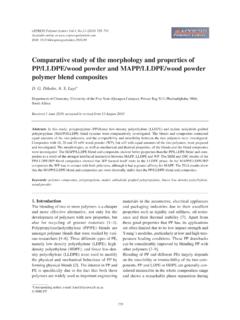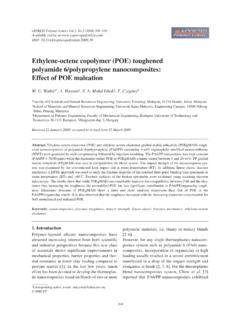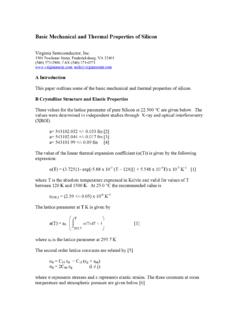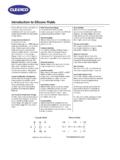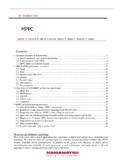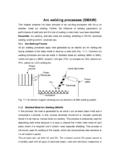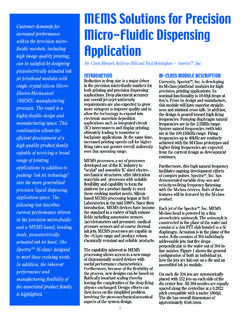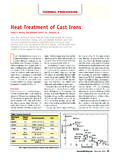Transcription of Effects of silicon surfactant in rigid polyurethane …
1 1. IntroductionPolyurethanes (PUs) are used as coatings, adhesive,sealants, elastomers (CASE), and fibers as well asflexible, semi- rigid and rigid foams [1 3]. Amongthem, rigid PU foams (RPUFs) have closed cellstructure with low thermal conductivity, high com-pression strength, low density, high strength-to-weight ratio, and low moisture permeability [2 4].Consequently, RPUFs finds such applications asinsulations of refrigerators, freezers, piping, tanks,ship building, and LNG cargos [5 8].The foaming can be done by one shot or two shotmethods.
2 In one shot method, all materials are putinto a mixing cup and mixed homogeneouslybefore they are poured into a mold. In the two shotmethod, isocyanate is added to the mixture at thesecond stage. The foaming can be carried out with aphysical blowing agent, chemical blowing agent, orwith a mixture of the two [5]. In physical blowing,reactions between isocyanate and polyol producepolyurethane linkages with the emission of heat ofreaction. Then, the blowing agent vaporizes and thegas trapped in the closed cells of the foam [9]. Typ-ically, thermal conductivity of the blown gas isvery low.
3 This, with small closed cell structuregives extremely low thermal conductivity of theRPUFs. In chemical blowing, water (most widelyused blowing agent) reacts with isocyanate to formunstable carbamic acid which immediately decom-poses into an amine and carbon dioxide [2, 10, 11].Recently, many of the conventional blowing agentssuch as monofluorotrichloromethane (R11) anddifluorodichloromethane (R12) have been sug-gested to contribute to the depletion of the stratos-pheric ozone layer and the use has been regulated inmany countries.
4 Consequently, the use of environ-mentally friendly blowing agents has become animportant and urgent issue in the synthesis ofpolyurethane foam [12 14]. Water can in partreplace such environmentally hazardous blowing194*Corresponding author, e-mail: BME-PT and GTEE ffects of silicon surfactant in rigid polyurethane foamsH. Lim2, S. H. Kim1, B. K. Kim1*1 Department of Polymer Science and Engineering Pusan National University, Busan 609-735, Korea2 Korea Polyol Co., Ulsan 680-090, KoreaReceived 28 November 2007; accepted in revised form 29 January rigid polyurethane foams (RPUFs) have been fabricated from high functional crude 4,4 -di-phenylmethanediisocyanate (CMDI) and polypropylene glycols (PPGs) for a wide range of surfactant concentration with an environmentlyfriendly blowing agent (HFC 365mfc).
5 Cream time, gel time, and tack-free time increased with the addition of density decreased rapidly to a minimum at pphp (part per hundred polyol) surfactant due to the increased blow-ing efficiency with surfactant . Surface tension rapidly decreased to an asymptotic value at 2 pphp surfactant . In accordancewith this, cell size decreased and closed cell content increased rapidly to constant values at low surfactant concentrations(<1 pphp). The decrease of cell size was accompanied by the decrease of thermal conductivity to give a linear relatiohshipbetween the two implying that the series model of heat transfer is :thermal properties, rigid polyurethane foam (RPUF), cell structure, compression strength, thermal conductivityeXPRESS Polymer Letters , (2008) 194 200 Available online at : However, the excessive use of water causesa negative pressure gradient due to the rapid diffu-sion of CO2through the cell wall causing celldeformation [2, 3, 15, 16].
6 The kinetics of RPUF formation mainly depends onthe rates of blowing and gelling reactions, which onthe other hand are respectively governed by anamine and a tin catalyst [4, 6]. On the other hand,the properties of the foam mainly depend on thetype of polyol such as functionality and hydroxylvalue, and type and amount of surfactant , andblowing agent. To reinforce the foam, compositeswith particle, clays and fiber have been considered[17 21].As far as the present authors are concerned, system-atic investigations of the Effects of surfactant onvarious properties of RPUF are sparse, perhapsexcept those blown with water [7, 22].
7 We synthe-sized various types of RPUFs from CMDI andpolypropylene glycols (PPGs) with an environmen-tally friendly physical blowing agent, viz. HFC365mfc (CF3CH2CF2CH3), with a potential targetapplication of insulation panel of LNG cargo wherehigh compression strength as well as thermal insu-lation is highly desired. The Effects of silicon sur-factant concentration on the performances of thefoams have been extensively analyzed in terms ofreactivity, cell morphology, surface tension, andmechanical and thermal properties of the Raw materialsTwo types of PPG having hydroxyl value (OHV,mg KOH/g of sample) of 450 and 400 (HR-450 Pand KR-403) were provided by Korea Polyol Co(Korea).
8 The CMDI was provided by Huntsman(Suprasec-5005), HFC 365mfc by Solvay Chemi-cals (Belgium), and Polycat-8 as foaming catalystby Air Products. silicon surfactant (B 8404) knownto augment the closed cell content thus providingimproved thermal insulation was provided byGoldschmidt. PPGs were dehydrated before use at90 C for 24 h in a vacuum oven. Other chemicalswere used as Preparation of samplesThe rigid foams were synthesized by one shotmethod. All raw materials were first put into a mix-ing vessel (Utra-Turrox T-50, Ika-Werke) andmixed for 30 s at 7000 rpm.
9 Then the mixtures weredischarged to an open mold (200 200 200 mm)and the foam cake was cured for 1 week at roomtemperature. The NCO index (isocyanate equiva-lents/polyol equivalents) was fixed at Thebasic formulations are given in Table CharacterizationsDensity of the foam was measured according toASTM D 1622 with sample size of 30 30 30 mm(width length thickness), and an average of atleast five measurements was taken to report. Thedensity distribution [%] was calculated accordingto 100 (maximum density-minimum density)/aver-age closed cell content was determined by an airpycnometer following ASTM D 2850 with speci-men dimension 50 50 25 mm.
10 Thermal conduc-tivity was measured using HC-074 (Laser Comp)according to ASTM C 518. The cell morphologywas observed under a scanning electron micro-scope (SEM, HITACHI S3500N). Samples werecryogenically fractured in liquid nitrogen and goldsputtered before they were scanned in the free ris-ing direction. Mechanical properties at room tem-perature were measured using a Universal TestingMachine (Ametek, Lloyd). Compression strengthwas determined by ASTM D 1621 at a crossheadspeed of mm/min with the sample dimension of30 30 30 mm [7].
